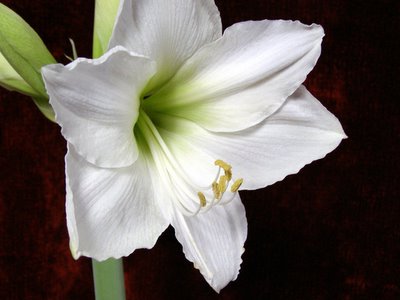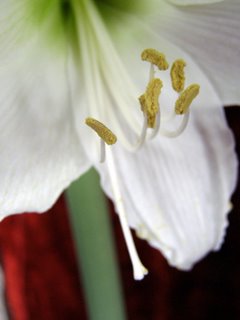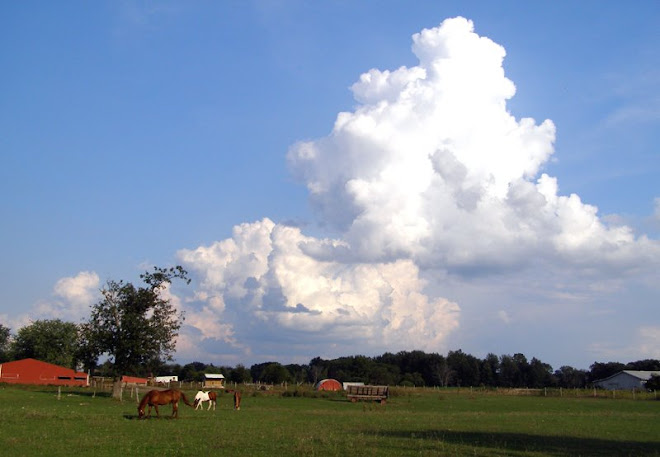
I wanted to plant an amaryllis bulb in time to bloom for the holidays. But I bought and planted it late, after Christmas in fact. I watered it faithfully, and after several weeks, last Wednesday my amaryllis bloomed.
It takes patience to wait for blossoms. For weeks you water the bulb in the pot, with no apparent result. The bulb's dry, homely neck and shoulders sit above the soil, and you're convinced nothing will ever come of it. Then, maybe four weeks in, a chartreuse tongue appears at the top of the bulb. Quickly, it seems, the stem grows. In just a few days it reaches eighteen inches. Then for another week or two, four chrysalis-like buds emerge from the very top of the stem and prepare to open. At last, one at a time, each bud flowers, facing east, south, west and north, like blades of a helicopter. The orbit of blooms is worth the long wait.
 I would like to propagate a bulb. This requires even more patience. You must pollinate the pistil with the pollen on the stamens, then wait for seeds to form in the ovary. After removing, drying and planting seeds, it takes three years for bulbs that will flower to grow.
I would like to propagate a bulb. This requires even more patience. You must pollinate the pistil with the pollen on the stamens, then wait for seeds to form in the ovary. After removing, drying and planting seeds, it takes three years for bulbs that will flower to grow.This is one of those areas of life where I ask, if someone else didn't do this for me (take care of propagating plants and bulbs so I can just plant them), would I know how to do it? I have one lifetime (maybe?). In this era of technology, what fundamental survival skills do I know? If all the computers crashed, what then? If I couldn't buy groceries, could I grow enough to sustain myself? If no one else repaired our mechanical gadgets, could I?
Though I may never have to depend on myself for some of this know-how, it is gratifying to learn at least a few such life lessons, to be more connected. My Donald, who knows how to do so many things, is patient with me as I grow.





8 comments:
So... are you going to do it- are you going to propagate the seeds?
Ruth, this post is so very wonderful! I know exactly what you mean about not wanting to be so dependent on everyone else. I'm sure it doesn't make sense to keep reinventing the wheel but there is surely something to be said for learninbg how to do things on our own.
And I love your photos! How did you learn to do those macro shots???
Rach: I think I will try it! The third bloom is opening today, and there will be one more. So I have four shots at it! I wonder . . . do I use a q-tip? Did you ever do this in your plant biology classes?
Ginnie: Thank you! I learned from the masters (you, PG, Paul). I'm experimenting with my new camera, which has many helpful settings. I love digital! Instant feedback, right?
Beautiful pictures, Ruth! I had a couple amaryllis in my wedding bouquet and just love everything about them. I don't have the patience to propagate the seeds, but I'll sure enjoy seeing pictures of the results! :-)
I read to use the tip of a dental hook or a toothpick. It said you can wet the tip with saliva if the pollen is dry and doesn't stick. It seems like a Q-tip would immitate a bee more closely, but maybe it's not as reliable, or maybe it could cause harm to the stigma if pressed too hard.
Then, maybe you can experiment in cross pollination and make an arabesque amaryllis.
i like rachel's idea of an arabesque amaryllis. i think you should definitely try to propogate. what an amazing idea.
Amy: I forgot you had them in your bouquet! (or,more likely, I didn't notice back then)
Rachel: Thanks for the lab info. I like the idea of cross propagation; next year I could buy one red and one white, then see if I can come up with arabesque. :)
Les: I could give you one of the seedlings!
New camera, Ruth? When and what? Inquiring minds and all....
Post a Comment